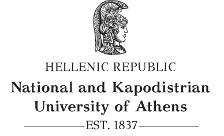- Αρχική
- THE PROGRAM
-
MODULES
- THE ARCHAEOLOGY OF BRONZE AGE AEGEAN (1010)
- KEY THEMES IN EASTERN MEDITERRANEAN ARCHAEOLOGY (1020)
- STATE FORMATION AND THE RISE OF POWER IN AN INSULAR WORLD: THE ARCHAEOLOGY OF MINOAN CRETE (3020)
- THE ARCHAEOLOGY OF MYCENAEAN GREECE (1050)
- COLLAPSE AND TRANSFORMATION: CRISIS, RESILIENCE, AND REORGANIZATION FROM THE LATE THIRD TO EARLY FIRST MILLENNIUM BCE IN THE EASTERN MEDITERRANEAN (3030)
- UNDERSTANDING THE ARCHAEOLOGICAL RECORD: PREHISTORIC CYPRUS AND THE EAST MEDITERRANEAN (2080)
- THE VISUAL CULTURES OF CLASSICAL GREECE (1030)
- ANCIENT GREEK SCULPTURE (1080)
- ATTIC POTTERY OF THE ARCHAIC AND CLASSICAL PERIODS (1090)
- THE ARCHITECTURE OF THE MYSTERY CULTS (2090)
- THE ARCHAEOLOGY OF DEATH IN THE ANCIENT GREEK WORLD (3010)
- STAFF
- ACTIVITIES
- ADMISSION
- RESOURCES
- CONTACT US
- NEWS AND EVENTS
THE ARCHAEOLOGY OF DEATH IN THE ANCIENT GREEK WORLD (3010)
Spring Semester, Optional course, 10 ECTS.
Instructor: Nikolas Dimakis
Summary
The transformations introduced by the rise of the polis in the Archaic (7th-6th c BC) and Classical (5th-4th c BC) periods and the gradual urbanization of society in the Hellenistic period (late 4th-1st c BC) resulted in the radical alteration of social life and dramatized an important part in the intensification of social differences. These developments are manifested in the burial topography and tomb architecture such as by the erection, always next to common grave forms, of lavish burial monuments in the Archaic period, communal graves or hoplite burials in the Classical period, Macedonian type tombs in the Hellenistic period. The overall burial expenditure is increased and emphasized by the carefully chosen location for these tombs in the natural or urban landscape, the deposition of non-/elaborate grave offerings, public burial rituals, etc.
Main aim of the course is to explore the archaeology of death in the Archaic, Classical and Hellenistic times from the burial topography and tomb architecture point of view. Grave types, grave/cemetery location, burial offerings rites and rituals from a wide range of case studies (e.g. Aigai, Alexandria, Athens, Corinth, Pella, Pergamon, Rhodes, Sparta) are examined within their sociopolitical context in order to familiarize students with the strategies of dealing with death in the ancient Greek world, and the theoretical and methodological approaches to the archaeology of death and burial.
Learning outcomes
By the end of this course students should be familiar with:
- grave typology of the Archaic, Classical and Hellenistic times.
- the burial context (architecture, topography, tomb architecture, grave goods).
- a representative range of the considerable corpus of archaeological evidence for Greek burial customs from the Archaic to the Hellenistic periods.
- the contribution of burial evidence to our understanding of the ancient Greek World.
- the theoretical approaches to the archaeology of death.
Syllabus
The course is structured around the following modules:
- Introduction
- Brief Historical Overview
- Theoretical Approaches
- Technical Guidelines (research methodology, analysis of burial remains, etc.)
- Monitoring of Student Assignments
- Presentation of Student Projects
- Study / Evaluation of Conclusions
Assessement
*Essay: 30%
Oral presentation: 10%
Written work: 60%
*Essay (3.500-5.000 words). A list of indicative topics will be provided, but students are strongly encouraged to discuss and personalize the essay topic with the course coordinator.
Student’s study hours
Lectures:30
Educational visits: 10
Interactive teaching: 10
Study and analysis of bibliography: 40
Cooperation with the instructor: 20
Tutorials: 10
Independent study (incl. project): 50
Essay writing: 80
Course total: 250
Recommended bibliography
Boardman, J. (1971). Greek Burial Customs. London
Fedak, J. (1990). Monumental Tombs of the Hellenistic Age. Toronto
Garland, R. (1985). The Greek Way of Death. London.
Morris, I. (1987). Burial and Ancient Society: the Rise of the Greek City-State. Cambridge
